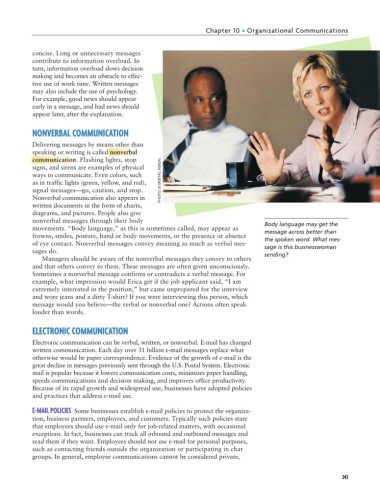Page 256 - Business Principles and Management
P. 256
Chapter 10 • Organizational Communications
concise. Long or unnecessary messages
contribute to information overload. In
turn, information overload slows decision
making and becomes an obstacle to effec-
tive use of work time. Written messages
may also include the use of psychology.
For example, good news should appear
early in a message, and bad news should
appear later, after the explanation.
NONVERBAL COMMUNICATION
Delivering messages by means other than
speaking or writing is called nonverbal
communication. Flashing lights, stop
signs, and sirens are examples of physical
ways to communicate. Even colors, such
as in traffic lights (green, yellow, and red), PHOTO: © DIGITAL VISION.
signal messages—go, caution, and stop.
Nonverbal communication also appears in
written documents in the form of charts,
diagrams, and pictures. People also give
nonverbal messages through their body
movements. “Body language,” as this is sometimes called, may appear as Body language may get the
message across better than
frowns, smiles, posture, hand or body movements, or the presence or absence the spoken word. What mes-
of eye contact. Nonverbal messages convey meaning as much as verbal mes- sage is this businesswoman
sages do. sending?
Managers should be aware of the nonverbal messages they convey to others
and that others convey to them. These messages are often given unconsciously.
Sometimes a nonverbal message confirms or contradicts a verbal message. For
example, what impression would Erica get if the job applicant said, “I am
extremely interested in the position,” but came unprepared for the interview
and wore jeans and a dirty T-shirt? If you were interviewing this person, which
message would you believe—the verbal or nonverbal one? Actions often speak
louder than words.
ELECTRONIC COMMUNICATION
Electronic communication can be verbal, written, or nonverbal. E-mail has changed
written communication. Each day over 31 billion e-mail messages replace what
otherwise would be paper correspondence. Evidence of the growth of e-mail is the
great decline in messages previously sent through the U.S. Postal System. Electronic
mail is popular because it lowers communication costs, minimizes paper handling,
speeds communications and decision making, and improves office productivity.
Because of its rapid growth and widespread use, businesses have adopted policies
and practices that address e-mail use.
E-MAIL POLICIES Some businesses establish e-mail policies to protect the organiza-
tion, business partners, employees, and customers. Typically such policies state
that employees should use e-mail only for job-related matters, with occasional
exceptions. In fact, businesses can track all inbound and outbound messages and
read them if they want. Employees should not use e-mail for personal purposes,
such as contacting friends outside the organization or participating in chat
groups. In general, employee communications cannot be considered private,
243

